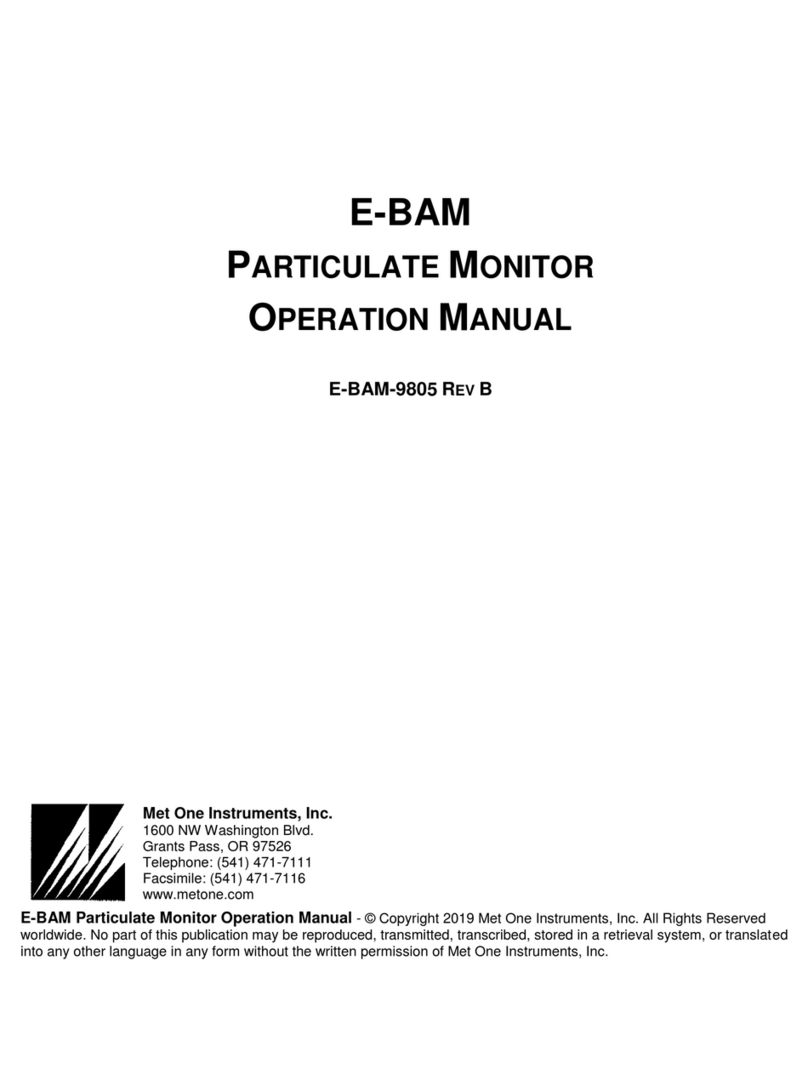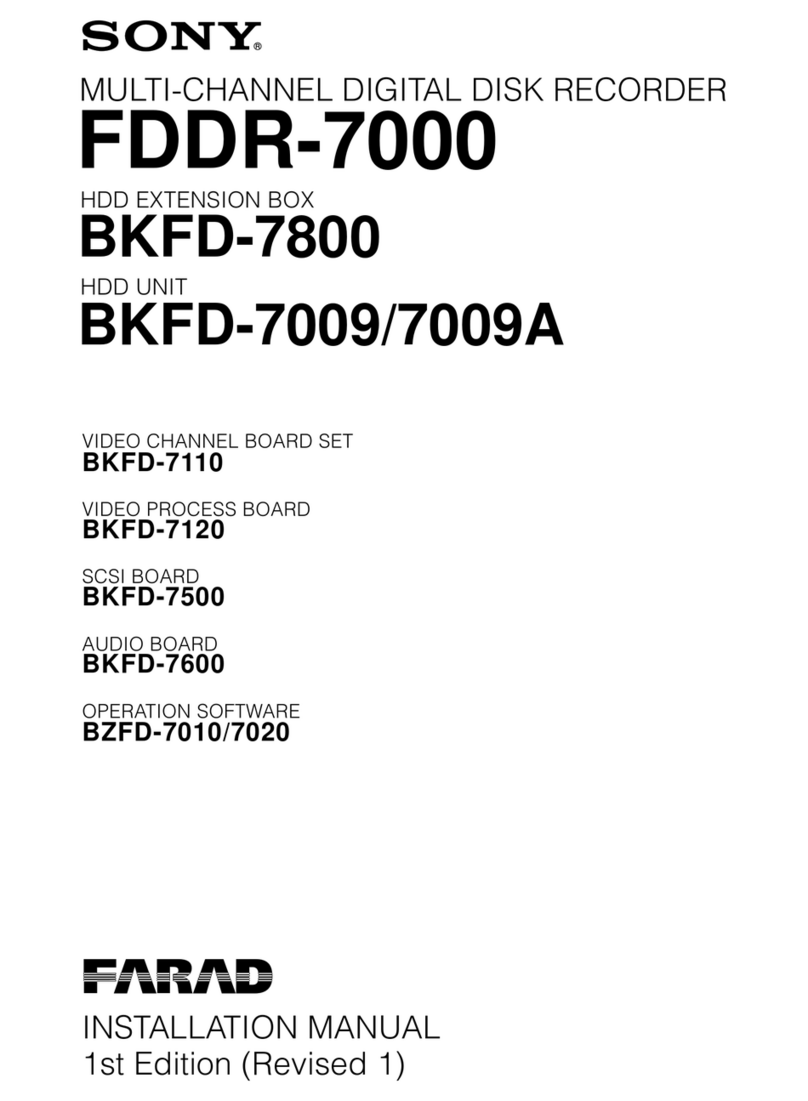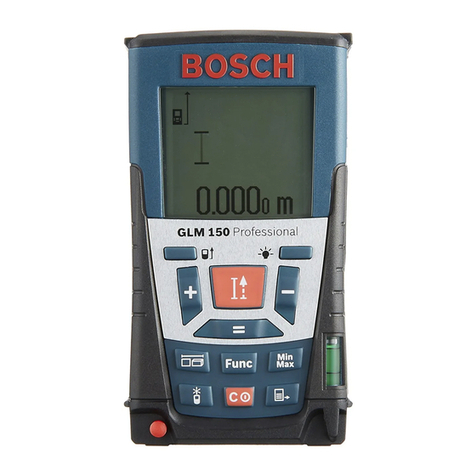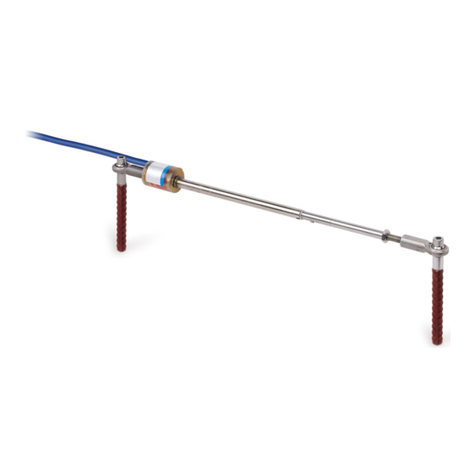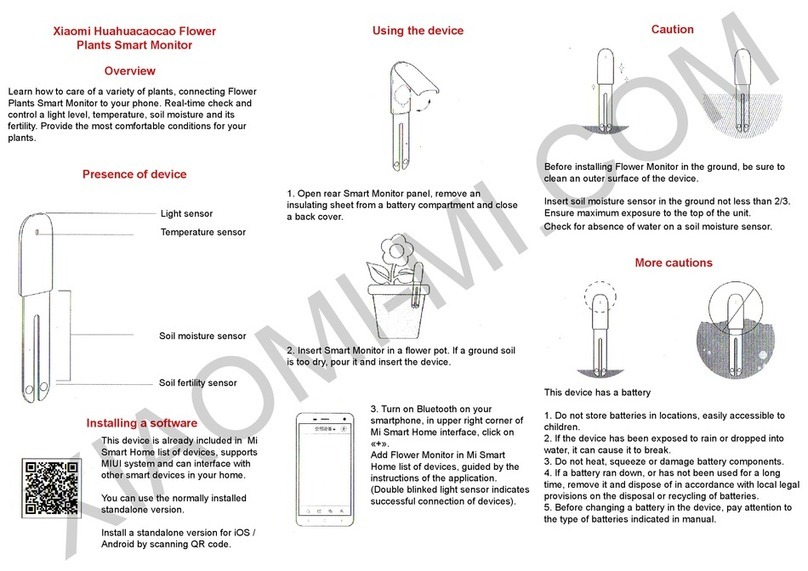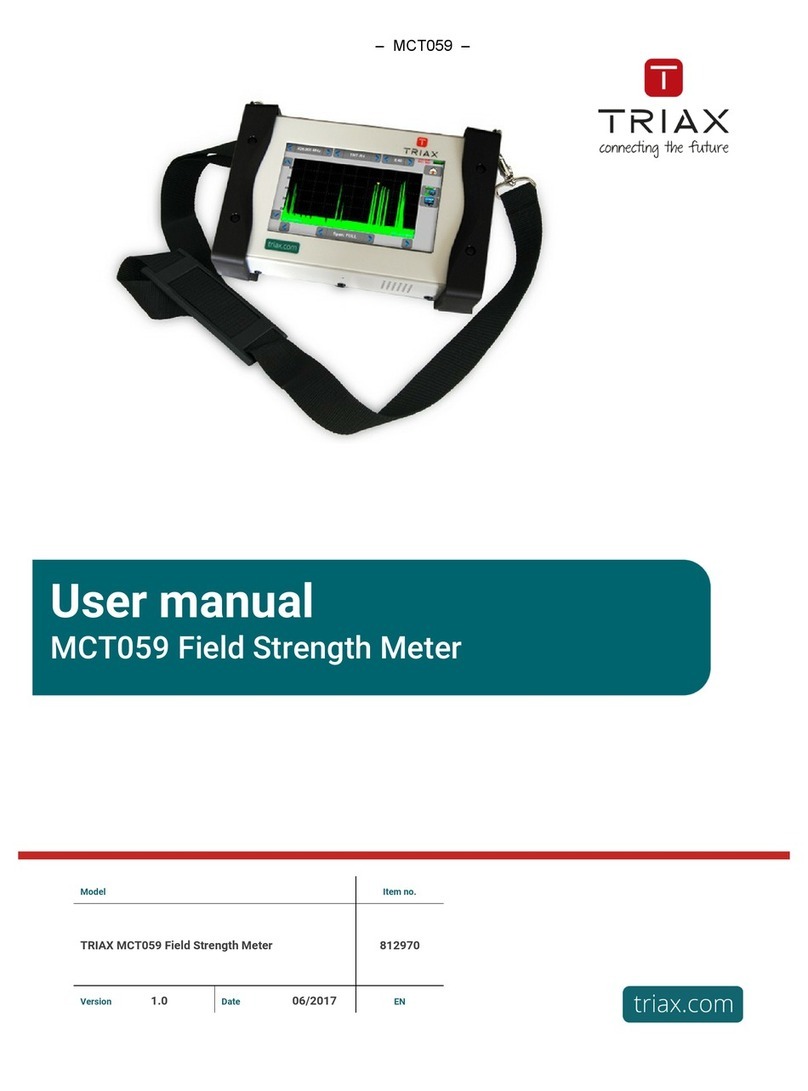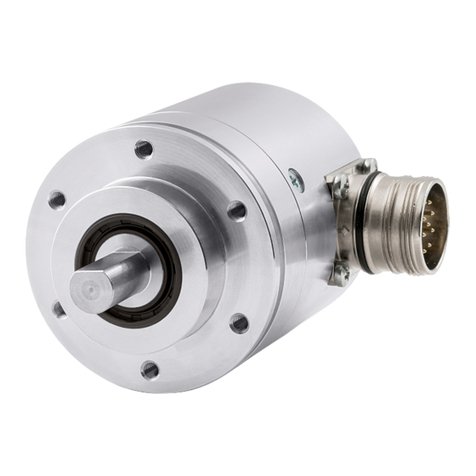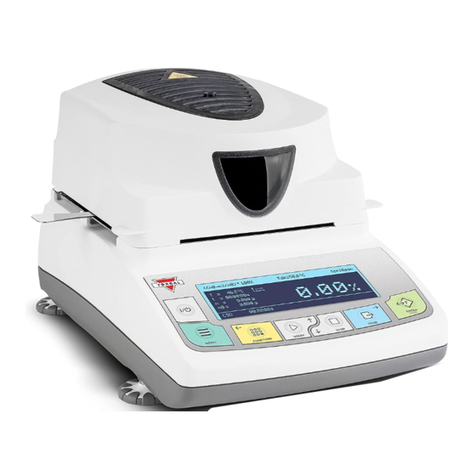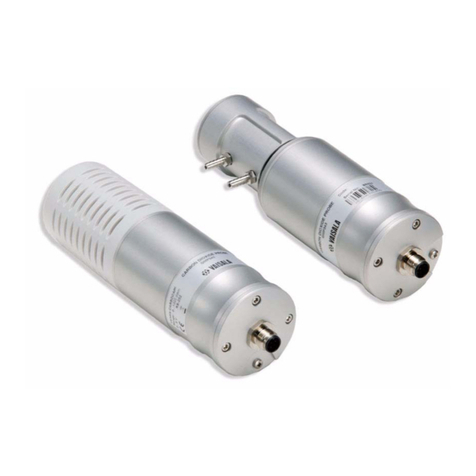Met One 831 User manual

831-9800 Rev D.doc
Met One Instruments, Inc
1600 Washington Blvd.
Grants Pass, Oregon 97526
Telephone 541-471-7111
Facsimile 541-471-7116
Regional Service
3206 Main St. Suite 106
Rowlett, Texas 75088
Telephone 972-412-4715
Facsimile 972-412-4716
MODEL 831
MANUAL

Model 831 Manual Page 1 831-9800 Rev D.doc
Copyright Notice
Model 831 Manual
© Copyright 2012 Met One Instruments, Inc. All Rights Reserved Worldwide. No part of
this publication may be reproduced, transmitted, transcribed, stored in a retrieval
system, or translated into any other language in any form by any means without the
express written permission of Met One Instruments, Inc.
Technical Support
Should you require support, please consult your printed documentation to resolve your
problem. If you are still experiencing difficulty, you may contact a Technical Service
representative during normal business hours—7:30 a.m. to 4:00 p.m. Pacific Standard
Time, Monday through Friday.
Voice: (541) 471-7111
Fax: (541) 471-7116
Mail: Technical Services Department
Met One Instruments, Inc.
1600 Washington Boulevard
Grants Pass, OR 97526
NOTICE
CAUTION—Use of controls or adjustments or performance of
procedures other than those specified herein may result in
hazardous radiation exposure.
WARNING—This product, when properly installed and operated, is
considered a Class I laser product. Class I products are not
considered to be hazardous.
There are no user serviceable parts located inside the cover of this device.
Do not attempt to remove the cover of this product. Failure to comply with this
instruction could cause accidental exposure to laser radiation.

Model 831 Manual Page 2 831-9800 Rev D.doc
Table of Contents
1.Introduction ........................................................................................................... 3
1.1.About the Measurement............................................................................................................3
2.Setup...................................................................................................................... 3
2.1.Unpacking..................................................................................................................................3
2.2.831 Layout.................................................................................................................................5
2.3.Initial Operation .........................................................................................................................5
3.Operation ............................................................................................................... 6
3.1.User Interface............................................................................................................................6
3.2.Power On/Off.............................................................................................................................6
3.3.Sample Modes...........................................................................................................................6
3.4.Start/Stop a Sample ..................................................................................................................6
3.5.Sample Screen..........................................................................................................................7
4.Settings Menu........................................................................................................ 7
4.1.To View Settings........................................................................................................................7
4.2.To Edit Settings .........................................................................................................................7
5.Serial Communications ...................................................................................... 10
5.1.Connection ..............................................................................................................................10
5.2.Commands ..............................................................................................................................10
5.3.Real Time Output ....................................................................................................................11
5.4.Comma Separated Value (CSV).............................................................................................11
6.Maintenance ........................................................................................................ 12
6.1.Charging the Battery................................................................................................................12
6.2.Service Schedule.....................................................................................................................12
6.3.Flash Upgrade.........................................................................................................................13
7.Troubleshooting.................................................................................................. 14
8.Specifications...................................................................................................... 15
9.Warranty / Service............................................................................................... 16

Model 831 Manual Page 3 831-9800 Rev D.doc
1. Introduction
The 831 is a small, lightweight, battery operated, handheld mass profiler. This
instrument simultaneously monitors PM1, PM2.5, PM4 and PM10 levels. The
multifunction rotary dial provides simple and efficient operation. The internal battery
pack provides 8 hours of continuous operation. The 831stores up to 2,500 sample
events, which can be viewed on the display or exported to a computer via the USB port.
1.1. About the Measurement
The 831 counts and sizes particles in 7 different size ranges then uses a proprietary
algorithm to convert count data to mass measurements (µg/m3). Fundamentally, the 831
calculates a volume for each detected particle then assigns a standard density for the
conversion.
The standard density value is adequate for most sampling environments. However,
some environments are heavily influenced by high or low density materials which can
reduce measurement accuracy. For these environments, the 831 provides a K-Factor
setting for each measurement range (PM1, PM2.5, PM4 and PM10). These K-Factors
can be modified with Comet software.
2. Setup
The following sections cover unpacking, layout and performing a test run to verify
operation.
2.1. Unpacking
When unpacking the 831 and accessories, inspect the carton for obvious damage. If
the carton is damaged notify the carrier. Unpack everything and make a visual
inspection of the contents. Standard items (included) are shown in Figure 1. Optional
accessories are shown in Figure 2.
ATTENTION:
The included USB driver CD must be installed before connecting the 831 USB port to
your computer. If the supplied drivers are not installed first, Windows may install
generic drivers that are not compatible with this product. See section 5.1.

Model 831 Manual Page 4 831-9800 Rev D.doc
Figure 1 – Standard Accessories
Figure 2 – Optional Accessories
Model 831 Optional Accessories
Model 831 Standard Accessories
831
MOI P/N: 831
Battery Charger
MOI P/N: 390031
USB Cable
MOI P/N: 500787
831 Manual
MOI P/N 831-9800
Calibration
Certificate
MOI P/N:
831-9600
Comet Software
CD
MOI P/N: 80248
USB Drivers CD
MOI P/N: 80328
Carrying Case
MOI P/N: 8517
Boot
MOI P/N: 80450
Zero Filter Kit
MOI P/N: 80846
Flow Meter Kit
MOI P/N: 80530

Model 831 Manual Page 5 831-9800 Rev D.doc
2.2. 831 Layout
The following figure shows the layout of the Model 831 and provides a description of the
components.
Figure 3 – 831 Layout
Component Description
Display 2X16 character LCD display
Keyboard 2 key membrane keypad
Rotary dial Multifunction dial (rotate and press)
Charger Jack Input jack for external battery charger.
Flow Adjust Adjusts the sample flow rate
Inlet Nozzle Sample nozzle
USB Port USB communication port
2.3. Initial Operation
The battery should be charged before initial operation. Refer to Section 6.1 of this
manual for battery charging information.
Complete the following steps to verify proper operation.
1. Press the Power key for 0.5 seconds or more to turn on power.
2. Observe the Startup screen for 3 seconds then the Sample screen (Section 3.5)
3. Press Start / Stop key. The 831 will sample for one minute and stop.
4. Observe the mass values on the display
5. Rotate the Select dial to view additional PM ranges.
6. The unit is ready for use
USB Port
Display
Charger Jack
Inlet Nozzle
Keyboar
d
Rotary Dial
Flow Adjust

Model 831 Manual Page 6 831-9800 Rev D.doc
3. Operation
The following sections cover the basic operation of Model 831.
3.1. User Interface
The 831 user interface is composed of a rotary dial, 2 button keypad and a LCD display.
The keypad and rotary dial are described in the following table.
3.2. Power On/Off
Press and hold the Power key momentarily for power on. Press the Power key for
power off. During power on, the 831 will display the Startup Screen (Figure 4) for
approximately 3 seconds then display the Sample Screen.
Model 831
WWW.METONE.COM
Figure 4 – Startup Screen
Note: The 831 will power down after 5 minutes to preserve battery power providing the
unit is stopped and there is no keyboard activity or USB communications.
3.3. Sample Modes
The 831 has two sample modes: Manual and Continuous (Section 4). Manual mode
configures the unit for single sample events. Continuous mode configures the unit for
nonstop sampling.
3.4. Start/Stop a Sample
Press the START/STOP key to start a measurement. The 831 will display the progress
bar below (Figure 5). In Manual mode, the 831 will sample for one minute and stop. In
Continuous mode, the 831 will run consecutive one-minute sample events until the
operator presses the START / STOP key or the battery is depleted.
SAMPLING...
██████████████
Figure 5 – Sampling Screen
Control Description
Power Key Power the unit on/off. For power on, press for 0.5 seconds or more.
Start/Stop Key Sample Screen START / STOP a sample event
Settings Menu Return to Sample screen
Edit Settings Cancel edit mode and return to the Settings Menu
Select Dial Rotate the dial to scroll through selections or change values. Press the
dial to select item or value.

Model 831 Manual Page 7 831-9800 Rev D.doc
3.5. Sample Screen
The Sample Screen displays mass measurement results. The first line displays the
Favorite range (default = PM2.5). Select a Favorite range in the Settings Menu (Section
4) and the 831 will pin the Favorite range to the top display line. The second line scrolls
(rotary dial) through the remaining ranges and battery capacity. The Sample Screen is
shown in Figure 6 below.
Figure 6 – Sample Screen
3.5.1. Warnings / Errors
Status messages are displayed on the second line of the Sample Screen. When this
occurs, simply rotate the dial to view any PM range on the top line.
A low battery warning indicates there is approximately 15 minutes of operation before
the 831 stops sampling. A low battery condition is shown in Figure 7 below.
PM2.5 50.3 µg
LOW BATTERY!
Figure 7 – Low Battery
The 831 will display “Sensor Noise” or “Sensor Error” if it detects a problem in the
particle sensor. If you observe one of these messages, contact the service center.
4. Settings Menu
Use the Settings Menu to view or change settings. The Settings Menu is shown in Table
1 below.
4.1. To View Settings
Press the Select dial to navigate to the Settings Menu. Rotate the Select dial to scroll
through the settings in Table 1. To return to the Sample screen press Start/Stop or wait
a few seconds and the unit will return automatically.
4.2. To Edit Settings
Press the Select dial to navigate to the Settings Menu. Rotate the Select dial to scroll to
the desired setting then press the Select dial to edit the Setting. A blinking cursor will
indicate edit mode. To cancel edit mode and return to the Settings Menu, press
Start/Stop.
PM2.5 50.3 µg
PM10 112.7 µg
Favorite range
Selectable (rotate dial)

Model 831 Manual Page 8 831-9800 Rev D.doc
Table 1, Settings Menu
Function Description
LOCATION Assign a unique number to a location or area. Range = 1 - 999
HISTORY Display previous samples. See Section 4.2.2
FREE
MEMORY Display the percent of available memory space. When Free
Memory = 0%, the oldest data will be overwritten with new data.
MODE Manual mode for single sample events.
Continuous mode for nonstop sampling.
FAVORITE Pin favorite PM range to the top display line.
TIME Display / set time. Time format is HH:MM:SS
(HH = Hours, MM = Minutes, SS = Seconds).
DATE Display / set date. Date format is DD/MMM/YYY
(DD = Day, MMM = Month, YYYY = Year)
ABOUT Display model number and firmware version
4.2.1. Location Number
Press to Change
LOCATION 001 View screen. Press Select to enter Edit mode.
Rotate and Press
LOCATION 001 Blinking cursor indicates Edit mode. Rotate dial to scroll value.
Press dial to select next digit. Repeat action until last digit.
Rotate and Press
LOCATION 001Rotate dial to scroll value. Press dial to exit Edit Mode and
return to view screen.
4.2.2. Sample History
Press to View
HISTORY Press Select to view history.
30/MAR/2011 L001
10:30:45 #1000
831 will display the last record (Date, Time, Location, and
Record Number). Rotate dial to scroll through records. Press to
view record.
PM1 12.8 µg
PM2.5 50.3 µg
PM4 72.4 µg
PM10 112.7 µg
Location 001
DATE 30/MAR/2011
TIME 10:30:45
Rotate dial to scroll through record data. Press Start/Stop to
return to previous screen.

Model 831 Manual Page 9 831-9800 Rev D.doc
4.2.3. Free Memory
Press to Change
FREE MEMORY 80% View available memory. Press Select to enter edit mode.
Press and Hold
to Clear Memory
Press and hold Select dial for 3 seconds to clear memory and
return to view screen. Return to view screen if no action for 3
seconds.
4.2.4. Mode
Press to Change
MODE MANUAL View screen. Press Select to enter Edit mode.
Rotate and Press
MODE MANUAL Blinking cursor indicates Edit mode. Rotate dial to toggle value.
Press dial to select value and return to view screen.
4.2.5. Favorite
Press to Change
FAVORITE PM2.5 View screen. Press Select to enter Edit mode.
Rotate and Press
FAVORITE PM2.5 Blinking cursor indicates Edit mode. Rotate dial to scroll
ranges. Press dial to select range and return to view screen.
4.2.6. Time
Press to Change
TIME 10:30:45 View time. Press Select to enter edit mode.
Rotate and Press
TIME 10:30:45 Blinking cursor indicates Edit mode. Rotate dial to scroll values.
Press dial to select next digit. Repeat action until last digit.
Rotate and Press
TIME 10:30:45Last digit. Rotate dial to scroll values. Press dial to exit Edit
mode and return to view screen.
4.2.7. Date
Press to Change
DATE 30/MAR/2011 View date. Press Select to enter edit mode.
Rotate and Press
DATE 30/MAR/2011 Blinking cursor indicates Edit mode. Rotate dial to scroll values.
Press dial to select next digit. Repeat action until last digit.
Rotate and Press
DATE 30/MAR/2011Rotate dial to scroll values. Press dial to exit Edit mode and
return to view screen.
4.2.8. About
831
80878-1 V1.0.0 View model number and firmware version.

Model 831 Manual Page 10 831-9800 Rev D.doc
5. Serial Communications
Serial communications, firmware field upgrades and real time output are provided via
the USB port located on the side of the unit.
5.1. Connection
ATTENTION:
The included USB driver CD must be installed before connecting the 831 USB port to
your computer. If the supplied drivers are not installed first, Windows may install generic
drivers that are not compatible with this product.
To install USB drivers:
Insert the USB Drivers CD. The install program should run automatically and display the
screen below. If an AutoPlay pop-up window appears, select “Run AutoRun.exe”.
Finally, select “USB Drivers” to start the install process.
5.2. Commands
The 831 provides serial commands for accessing stored data and settings. The protocol
is compatible with terminal programs such as Windows HyperTerminal.
The unit returns a prompt (‘*’) when it receives a carriage return to indicate a good
connection. Serial commands and descriptions are listed in Table 2 below.
Note:
For proper communication, set the
virtual COM port baud rate to 38400

Model 831 Manual Page 11 831-9800 Rev D.doc
Table 2, Serial Commands
Protocol Summary:
38,400 Baud, 8 Data bits, No Parity, 1 Stop Bit
Commands (CMD) are UPPER or lower case
Commands are terminated with a carriage return <CR>
To view setting = CMD <CR>
To change setting = CMD <SPACE> <Value> <CR>
CMD Type DESCRIPTION
?,H Help View the help menu
1 Settings View the settings
2 All data Returns all available records.
3 New data Returns all records since last ‘2’, ‘3’ or ‘4’ command.
4 Last data Returns the last record or last n records (n = <Value>)
D Date Change date. Date is format is MM/DD/YY
T Time Change time. Time format is HH:MM:SS
C Clear data Displays a prompt for clearing the stored unit data.
S Start Start a sample
E End Ends a sample (abort the sample, no data record)
ID Location View / change the location number. Range 1-999.
OP Op Status Replies OP x, where x is “S” Stopped or “R” Running
RV Revision View Software Revision
SM Mode 0 = Manual, 1 = Continuous
SK K-Factor
View / change K-Factors
x = 1 - 4 (PM1, PM2.5, PM4, PM10)
y = K-Factor value
Range = 0.10 to 9.99
5.3. Real Time Output
The 831 outputs real time data at the end of each sample. The output format is a
comma separated values (CSV). The following sections show the format.
5.4. Comma Separated Value (CSV)
A CSV header is included for multiple record transfers like Display All Data (2) or
Display New Data (3).
CSV Header:
Time, Location, PM1, PM2.5, PM4, PM10, Status
CSV Example Record:
31/AUG/2010 14:12:21,001,12.8,50.3,72.4,112.7,000<CR><LF>

Model 831 Manual Page 12 831-9800 Rev D.doc
Note: Status bits: 000 = Normal, 016 = Low Battery, 032 = Sensor Error, 64 = Sensor
Noise, 112 = Low battery, Senor Error and Sensor Noise.
6. Maintenance
WARNING:
There are no user serviceable components inside this instrument. The covers
on this instrument should not be removed or opened for servicing, calibration
or any other purpose except by a factory-authorized person. To do so may
result in exposure to invisible laser radiation that can cause eye injury.
6.1. Charging the Battery
Caution:
The provided battery charger is designed to work safely with this device. Do
not attempt to connect any other charger or adapter to this device. Doing so
may result in equipment damage.
To charge the battery, connect the battery charger module AC power cord to an AC
power outlet and the battery charger DC plug to the socket on the side of the 831. The
universal battery charger will work with power line voltages of 100 to 240 volts, at 50/60
Hz. The battery charger LED indicator will be Red when charging and Green when fully
charged. A discharged battery pack will take approximately 2.5 hours to fully charge.
When fully charged, the battery will power the 831 for approximately 8 hours of
continuous sampling or 24 hours of intermittent sampling. For extended operation,
operate the unit with the battery charger attached. Also, charge the battery before
storing the 831. Storing a discharged battery will degrade its performance.
6.2. Service Schedule
Table 3 shows the recommended service schedule for the 831.
Table 3, Service Schedule
Item To Service Frequency Done By
Flow rate test Monthly Customer
Zero test Optional Customer or Factory Service
Calibrate Sensor Yearly Factory service only
6.2.1. Flow Rate Test
The sample flow rate is factory set to 0.1cfm (2.83 lpm). Continued use and ambient
temperature/pressure variations may cause minor changes in flow which can reduce
measurement accuracy. A flow calibration kit is available separately that includes
everything needed to test/adjust the flow rate. To test the flow rate:
Remove the inlet screen holder
Connect the flow meter with inlet adapter (MOI# 80530) to the instrument inlet

Model 831 Manual Page 13 831-9800 Rev D.doc
Start a sample
Observe the flow meter reading after approximately 30 seconds
The flow rate should be 0.1 CFM (2.83 LPM) 5%
If the flow is not within this tolerance, it can be adjusted using a trim pot located in an
access hole in the side of the unit. Turn the adjustment pot clockwise to increase the
flow and counter-clockwise to decrease the flow.
6.2.2. Zero Count Test
The 831 automatically monitors system noise and displays a System Noise warning
when the noise level is high (see Section 3.5.1). This diagnostic reduces the necessity
for an inlet filter zero count test. However, a zero count kit can be purchased separately
if desired.
6.2.3. Annual Calibration
The 831 should be sent back to Met One Instruments yearly for calibration and
inspection. Particle counter calibration requires specialized equipment and training.
The Met One Instruments calibration facility uses industry accepted methods such as
ISO and JIS.
In addition to calibration, the annual calibration includes the following preventative
maintenance items to reduce unexpected failures:
Inspect the exhaust filter
Inspect and clean the optical sensor
Inspect the pump/tubing
Cycle and test the battery
6.3. Flash Upgrade
Firmware can be field upgraded via the USB port. Binary files and the flash program
must be provided by Met One Instruments.

Model 831 Manual Page 14 831-9800 Rev D.doc
7. Troubleshooting
The following table covers some common failure symptoms, causes and solutions.
Symptom Possible Cause Correction
Low battery message Low battery Charge battery 2.5 hrs
Sensor Noise Possible contamination Contact service center
Sensor Error Sensor failure Send to service center
Does not turn on, no
display 1. Dead battery
2. Defective Battery 1. Charge battery 2.5 hrs
2. Send to service center
Display turns on but pump
does not 1. Low Battery
2. Defective pump 1. Charge battery 2.5 hrs
2. Send to service center
Low measurement values 1. Low flow rate
2. Inlet screen clogged 1. Check flow rate
2. Check inlet screen
High measurement values 1. High flow rate
2. Calibration 1. Check flow rate
2. Send to service center
Battery pack does not hold
a charge
1. Defective battery pack
2. Defective charger
module
1. Send to service center
2. Contact service center

Model 831 Manual Page 15 831-9800 Rev D.doc
8. Specifications
Operating Principle Particle count to mass conversion
Features
Sample Duration 1 minute
Sample Modes Manual and Continuous
Data storage 2,500 records
Display 2-line by 16-character LCD
Controls 2 button keypad with rotary dial
Calibration NIST, ISO, JIS
Performance
PM Levels PM1, PM2.5, PM4 and PM10
Concentration Range 0 – 1,000 µg/m3
Resolution 0.1µg/m3 (display / serial output)
Sensitivity 0.5µm
Accuracy ± 10% to calibration aerosol
Flow rate 0.1 CFM (2.83 lpm)
Electrical
Light Source Laser Diode, 780 nm, 40 mW (typical)
AC Adapter/Charger AC to DC module, 100 – 240 VAC to 8.4 VDC
Battery Type Li-ion rechargeable Battery
Battery Operating Time 8 hours continuous operation
24 hour intermittent operation
Battery Recharge Time 2.5 hours typical
Communication USB Mini B Type
Physical
Height 6.25” (15.9 cm)
Width 3.63” (9.22 cm)
Thickness 2.00” (5.08 cm)
Weight 1.74 lbs – 28 ounces – (0.79 kg)
Environmental
Operating Temperature 0º C to +50º C
Storage Temperature -20º C to +60º C
Accessories
Battery charger / adapter
USB Cable
Operation manual
Comet software

Model 831 Manual Page 16 831-9800 Rev D.doc
9. Warranty / Service
Warranty
Products manufactured by Met One Instruments, Inc. are warranted against defects
and workmanship for a period of two (2) years from the ship date.
Any product found to be defective during the warranty period will, at the option of
Met One Instruments, Inc., be replaced or repaired. In no case shall the liability of
Met One Instruments, Inc. exceed the purchase price of the product.
This warranty may not apply to products that have been subject to misuse,
negligence, accident, acts of nature, or that have been altered or modified other than
by Met One Instruments, Inc. Consumable items such as filters, bearings pumps and
batteries are not covered under this warranty.
Other than the warranty set forth herein, there shall be no other warranties, whether
expressed, implied or statutory, including warranties of fitness of merchantability.
Service
Any product being returned to Met One Instruments, Inc. for service, repair or
calibration, including items sent for warranty repair, must be assigned a return
authorization (RA) number. Please call (541) 471-7111 or send an email to
All returns must be shipped to the factory, freight pre-paid. Met One Instruments, Inc.
will pay the shipping charge to return the product to the end user after repair or
replacement of an item covered by warranty.
All instruments sent to the factory for repair or calibration must be free of
contamination resulting from sampling chemicals, biological matter, or radioactive
materials. Any items received with such contamination will be disposed and the
customer will be billed a disposal fee.
Replacement parts or service/repair work performed by Met One Instruments, Inc.
are warranted against defects in material and workmanship for a period of ninety
(90) days from the date of shipment, under the same conditions as stated above.
REV 2011
Other manuals for 831
1
Table of contents
Other Met One Measuring Instrument manuals
Popular Measuring Instrument manuals by other brands
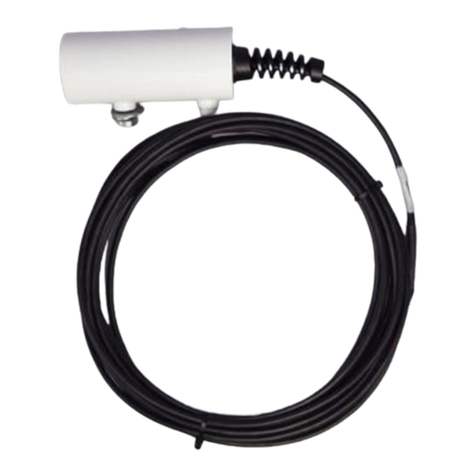
Apogee Instruments
Apogee Instruments SIL-111 owner's manual
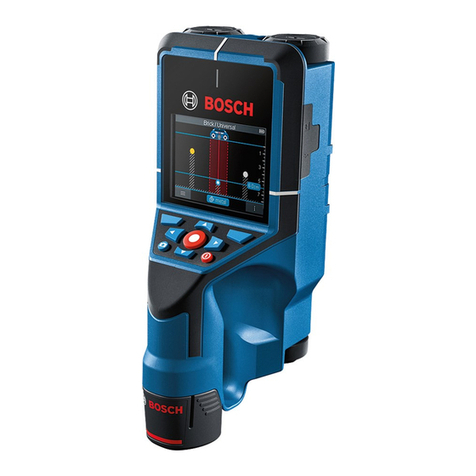
Bosch
Bosch 200 C Original instructions
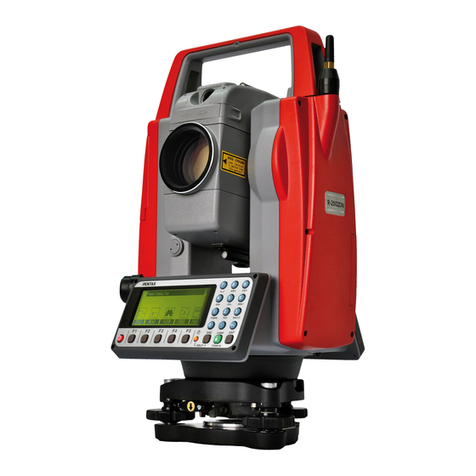
Pentax
Pentax R-2500DN Series instruction manual
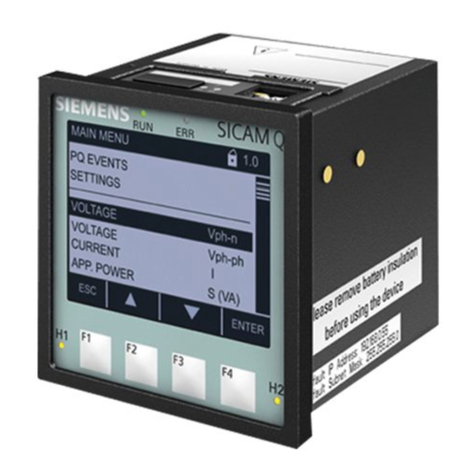
Siemens
Siemens SICAM Q100 7KG95 Series manual
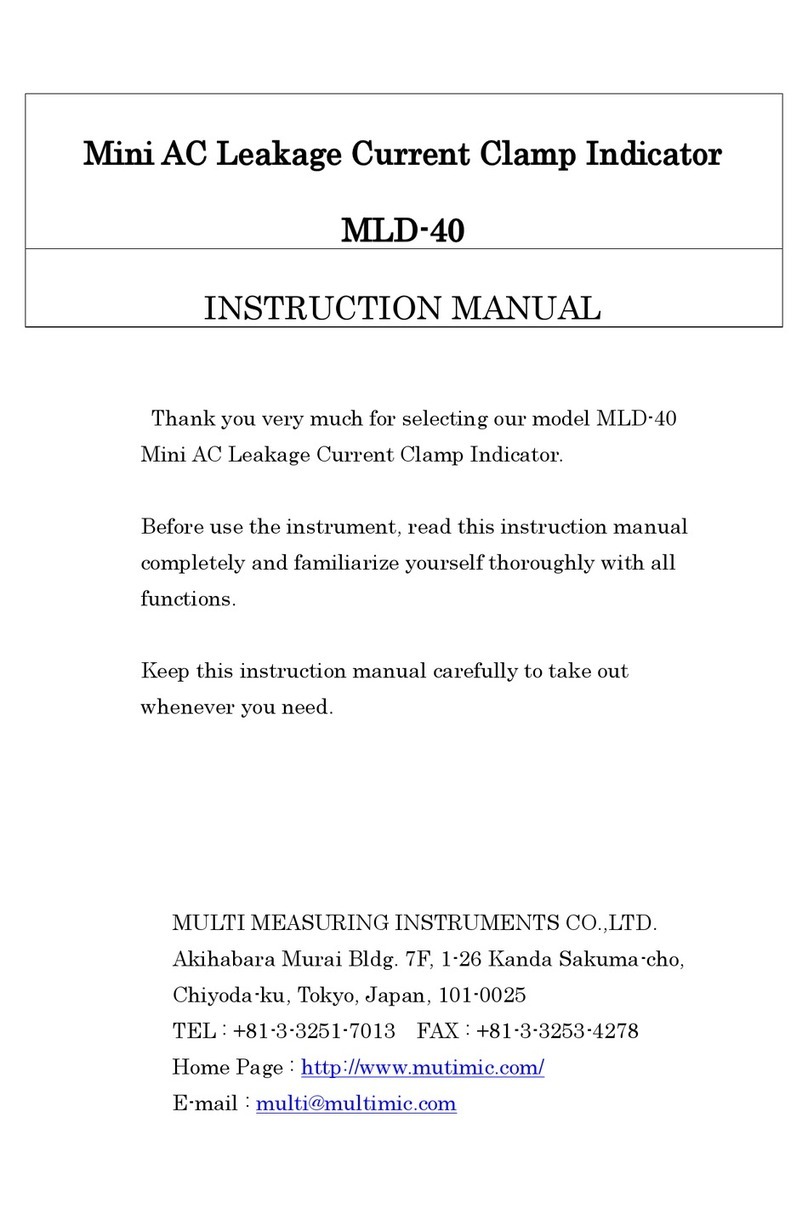
MULTI MEASURING INSTRUMENTS
MULTI MEASURING INSTRUMENTS MLD-40 instruction manual
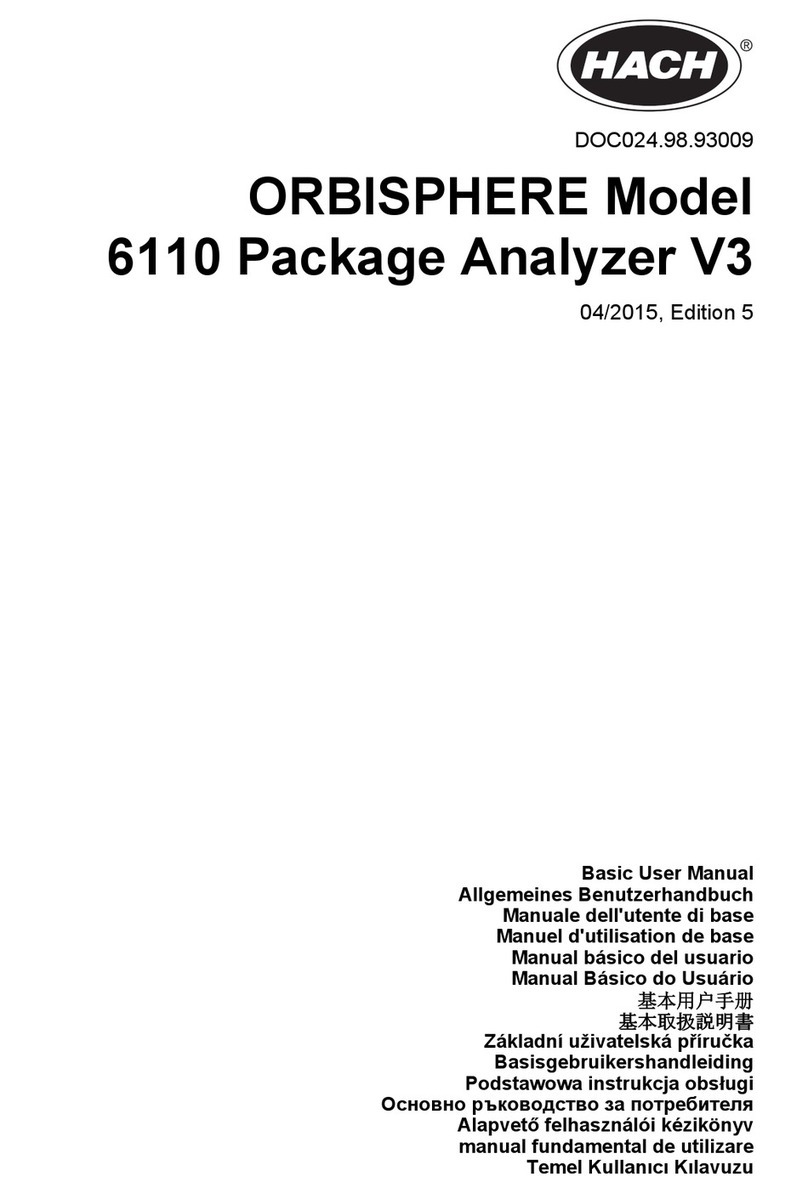
Hach
Hach ORBISPHERE 6110 user manual



